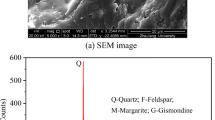Abstract
Sections of struvite kidney stones were tested in compression at high strain rates (∼3000 s−1) using a Kolsky bar and at low strain rates (<0.001 s−1) using an Instron testing machine. The peak stress in both cases appeared to be similar. At high strain rates the values of flow stress measured were between 40 and 65 MPa and at low strain rates they were between 37 and 58 MPa. However, the morphology of the damage was dramatically different. Stones tested at low strain rates formed a small number of cracks but otherwise remained intact at the end of the test. In comparison, stones tested at high strain rates were reduced to a powder. Kidney stones are a two-phase material consisting of a crystalline ceramic phase and an organic binder. We speculate that in the high strain rate tests the large difference in the sound speed between the matrix and the crystalline grains leads to shear stresses that destroy the stone. These data indicate that shear stress induced by the internal structure may be a mechanism by which shock waves comminute kidney stones in lithotripsy.
Similar content being viewed by others
References
K. Kerbl, J. Rehman, J. Landman, D. Lee, C. Sundaram and R. V. Clayman, J. Endourol. 16 (2002) 281.
B. Sturtevant, in “Textbook of Endourology”, edited by A. D. Smith, G. H. Badlani, R. V. Clayman, G. H. Jordan, L. R. Kavoussi, J. R. Lingeman, G. M. Preminger and J. W. Segura (Quality Medical Publishing, St. Louis, 1996) p. 529.
A. P. Evan, L. R. Willis, J. E. Lingeman and J. A. McAteer, Nephron 78 (1998) 1.
J. E. Lingeman and J. R. Newmark, in “Adverse Bioeffects of Shock Wave Lithotripsy, in Kidney Stones: Medical and Surgical Management”, edited by F. L. Coe, M. J. Favus, C. Y. C. Pak and G. M. Preminger (Lippincott-Raven, Philadelphia, 1996) p. 605.
F. Ebrahimi and F. Wang, J. Biomed. Mater. Res. 23 (1989) 507.
P. S. Follansbee, in “Metals Handbook: Mechanical Testing”, Vol. 8 (American Society For Metals, Metal Park, Ohio, 1985) p. 198.
H. Kolsky, “Stress Waves in Solids” (Dover Publications, Inc., New York, 1963) p. 30.
S. R. Khan, B. Finlayson and R. L. Hackett, Scanning Electron Microsc. 5 (1983) 379.
S. R. Khan and R. L. Hackett, ibid. 6 (1984) 935.
K. M. Kim, ibid. 4 (1982) 1635.
G. Pittomvils, J. P. Lafaut, H. Vandeursen, R. Boving, L. Baert and M. Wevers, Ultrasonics 33 (1995) 463.
G. Pittomvils, J. P. Lafaut, H. Vandeursen, R. Boving, L. Baert and M. Wevers, ibid. 34 (1996) 571.
N. P. Cohen and H. N. Whitfield, World J. Urol. 11 (1993) 13.
A. J. Coleman and J. E. Saunders, Ultrasonics, 31 (1993) 75.
P. Zhong, C. J. Chuong, R. D. Goolsby and G. M. Preminger, Biomed. Mater. Res. 25 (1992) 1117.
R. O. Cleveland, R. A. Muller and J. A. McAteer, J. Accous. Soc. Am. 110 (2001) 1733.
Author information
Authors and Affiliations
Rights and permissions
About this article
Cite this article
Sylven, E.T., Agarwal, S., Briant, C.L. et al. High strain rate testing of kidney stones. Journal of Materials Science: Materials in Medicine 15, 613–617 (2004). https://doi.org/10.1023/B:JMSM.0000026383.94515.a8
Issue Date:
DOI: https://doi.org/10.1023/B:JMSM.0000026383.94515.a8




